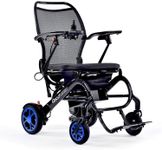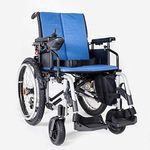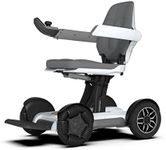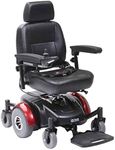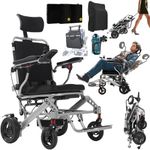Buying Guide for the Best Electric Wheelchairs
Choosing the right electric wheelchair is crucial for ensuring mobility, comfort, and independence. When selecting an electric wheelchair, it's important to consider your specific needs, lifestyle, and the environments in which you'll be using the wheelchair. Understanding the key specifications will help you make an informed decision that best suits your requirements.Weight CapacityWeight capacity refers to the maximum weight the wheelchair can safely support. This is important to ensure the wheelchair can accommodate the user comfortably and safely. Weight capacities typically range from 250 to 600 pounds. If you are close to the upper limit of a wheelchair's weight capacity, it's advisable to choose a model with a higher capacity to ensure durability and performance.
Battery RangeBattery range indicates how far the wheelchair can travel on a single charge. This is crucial for planning daily activities and ensuring you don't run out of power unexpectedly. Ranges can vary from 10 to 25 miles. Consider your daily routine and the distances you typically travel. If you plan to use the wheelchair for longer trips or in areas without easy access to charging, opt for a model with a longer range.
SpeedSpeed refers to how fast the wheelchair can travel. This is important for matching your pace with others and for efficient travel. Speeds usually range from 3 to 8 mph. If you need to keep up with faster-paced environments or prefer quicker travel, a higher speed may be beneficial. However, for indoor use or more controlled environments, a lower speed might be sufficient.
Turning RadiusTurning radius is the smallest circular turn the wheelchair can make. This is important for maneuverability, especially in tight spaces like indoors or crowded areas. A smaller turning radius, typically around 20 inches, is ideal for indoor use, while a larger turning radius may be acceptable for outdoor use where space is less restricted.
Seat Size and ComfortSeat size and comfort are crucial for ensuring a comfortable ride, especially for extended periods. This includes the width, depth, and padding of the seat. Seat widths generally range from 16 to 24 inches. Choose a seat size that accommodates your body comfortably, and consider additional features like adjustable armrests or backrests for enhanced comfort.
PortabilityPortability refers to how easy it is to transport the wheelchair, whether it can be folded or disassembled. This is important if you need to travel frequently or store the wheelchair in a vehicle. Lightweight and foldable models are easier to transport, but may have fewer features. Consider how often you'll need to transport the wheelchair and choose a model that balances portability with your other needs.
Terrain CapabilityTerrain capability indicates the types of surfaces the wheelchair can handle, such as indoor flooring, sidewalks, or rough outdoor terrain. This is important for ensuring the wheelchair can navigate the environments you frequent. If you plan to use the wheelchair outdoors or on uneven surfaces, look for models with larger wheels and better suspension. For primarily indoor use, a model designed for smooth surfaces may suffice.


